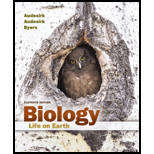
Concept explainers
Polar molecules
a. dissolve in lipids.
b. are hydrophobic.
c. form covalent bonds.
d. form ionic bonds.
Introduction:
Molecules can be broadly classified as polar or nonpolar. Polar molecules have an unequal distribution of electrons in their outermost orbitals giving a positive charge to one end of the molecule and negative charge to the other end. This unequal distribution of charges is responsible for the unique properties of polar molecules.
Answer to Problem 1MC
Correct answer:
Polar molecules form ionic bonds.
Explanation of Solution
Explanation for the correct answer:
Ionic bonds are formed by electrostatic interactions between oppositely charged ions. The atoms, which have gained extra electrons, are negatively charged (anions) and the atoms, which have lost electrons, are positively charged (cations). Such atoms can combine together by an ionic bond and form polar molecules. Option (d) is given that polar molecules form ionic bonds. Hence, option (d) is correct.
Explanation for incorrect answers:
Option (a) is given that polar molecules dissolve in lipids. Polar molecules are attracted to other polar molecules. Water is a polar molecule which makes all polar molecules water soluble. Oil is a nonpolar molecule that makes all nonpolar molecules lipid soluble. So, it is an incorrect answer.
Option (b) is given that polar molecules are hydrophobic. Polar molecules can dissolve in water which means that they are hydrophilic or ‘water-loving.’ So, it is an incorrect option.
Option (c) is given that polar molecules form covalent bonds. Covalent bonds are formed by the sharing of electron pairs between the atoms. This sharing of electrons gives the molecule a stable bond in which the attractive and repulsive forces are balanced. So, this is an incorrect option.
Hence options (a), (b), and (c) are incorrect.
Therefore, polar molecules are formed by ionic bonds between a cation and an anion. They are hydrophilic or water-soluble in nature.
Want to see more full solutions like this?
Chapter 3 Solutions
Biology: Life on Earth (11th Edition)
- Which of the following does not contribute to the tertiary structure of protein? a. ionic interaction b. H-bond c. peptide bond d. hydrophobic interactionarrow_forwardWhat type of bonding is present in the primary structure of proteins? A. peptide bond B. hydrogen bond C. ionic bond D. more than one choice is correctarrow_forward.Amino acids a. have high dipole moments. b. are weak acids. c. with high molecular masses will be insoluble in water. d. are weak bases. Which statement is false?arrow_forward
- The building blocks of nucleic acids are a. amino acids. b. fatty acids. c. monosaccharides. d. nucleotides. e. lipids.arrow_forwardWhich type of interaction stabilizes the alpha (α) helix and the beta (β) pleated sheet structures of proteins? Group of answer choices A. hydrophobic interactions B. peptide bonds C. hydrogen bonds D. nonpolar covalent bonds E. ionic bondsarrow_forwardThe molecule shown is a H H H H H H H H H H I I I I I I H-C-C-C-C-C-C-C-C-C- C-C H A. polypeptide. B. saturated fatty acid. C. polysaccharide D. unsaturated fatty acid.arrow_forward
- Which of the following statements about chemicalbonds is true?a. Covalent bonds are stronger than ionic bonds.b. Hydrogen bonds occur between two atoms ofhydrogen.c. Bonding readily occurs between nonpolar andpolar molecules.d. A molecule of water is unlikely to bond with anion.arrow_forwardThis type of noncovalent bond is responsible for clustering fatty acid tails of phospholipids in a micelle. a. Disulfide bonds b. Hydrogen bonds c. Hydrophobic interactions d. Ionic interactions e. van der Waals interactionsarrow_forwardThis occurs when the cations and anions are attracted to the positive and negative ends of water molecules: A. ionic bonding B. dissociation C. covalent bonding D. hydrogen bondingarrow_forward
- 8) Define the following terms: a. Hydrophobic b. Hydrophillic 9) Describe the composition of a phospholipid and its relationship with water. Be specific about how the different parts of a phospholipid interact with water.arrow_forwardLooking at the two different types of molecules (glycerol and fatty acids), describe the molecules with respect to: a. Polarity b. Acidityarrow_forwardWhich of the following is the characteristic that is common to all lipids?* A. They are made up of lots of double bonds B. They are acidic when mixed with water C. They are insoluble in water D. They do not have high energy contentarrow_forward
 Human Anatomy & Physiology (11th Edition)BiologyISBN:9780134580999Author:Elaine N. Marieb, Katja N. HoehnPublisher:PEARSON
Human Anatomy & Physiology (11th Edition)BiologyISBN:9780134580999Author:Elaine N. Marieb, Katja N. HoehnPublisher:PEARSON Biology 2eBiologyISBN:9781947172517Author:Matthew Douglas, Jung Choi, Mary Ann ClarkPublisher:OpenStax
Biology 2eBiologyISBN:9781947172517Author:Matthew Douglas, Jung Choi, Mary Ann ClarkPublisher:OpenStax Anatomy & PhysiologyBiologyISBN:9781259398629Author:McKinley, Michael P., O'loughlin, Valerie Dean, Bidle, Theresa StouterPublisher:Mcgraw Hill Education,
Anatomy & PhysiologyBiologyISBN:9781259398629Author:McKinley, Michael P., O'loughlin, Valerie Dean, Bidle, Theresa StouterPublisher:Mcgraw Hill Education, Molecular Biology of the Cell (Sixth Edition)BiologyISBN:9780815344322Author:Bruce Alberts, Alexander D. Johnson, Julian Lewis, David Morgan, Martin Raff, Keith Roberts, Peter WalterPublisher:W. W. Norton & Company
Molecular Biology of the Cell (Sixth Edition)BiologyISBN:9780815344322Author:Bruce Alberts, Alexander D. Johnson, Julian Lewis, David Morgan, Martin Raff, Keith Roberts, Peter WalterPublisher:W. W. Norton & Company Laboratory Manual For Human Anatomy & PhysiologyBiologyISBN:9781260159363Author:Martin, Terry R., Prentice-craver, CynthiaPublisher:McGraw-Hill Publishing Co.
Laboratory Manual For Human Anatomy & PhysiologyBiologyISBN:9781260159363Author:Martin, Terry R., Prentice-craver, CynthiaPublisher:McGraw-Hill Publishing Co. Inquiry Into Life (16th Edition)BiologyISBN:9781260231700Author:Sylvia S. Mader, Michael WindelspechtPublisher:McGraw Hill Education
Inquiry Into Life (16th Edition)BiologyISBN:9781260231700Author:Sylvia S. Mader, Michael WindelspechtPublisher:McGraw Hill Education





